Short Notes: Liberalisation, Privatisation, and Globalisation: An Appraisal | Economics Class 12 - Commerce PDF Download
| Table of contents |

|
| Introduction |

|
| Background: The 1991 Economic Crisis |

|
| What is Liberalisation? |

|
| What is Privatisation? |

|
| What is Globalisation? |

|
| Impact of Reforms: An Assessment |

|
| Conclusion |

|
Introduction
After gaining independence in 1947, India adopted a mixed economy, combining elements of capitalism and socialism. By the late 1980s, excessive government spending, inflation, and low foreign exchange reserves triggered a severe economic crisis in 1991. With reserves barely covering two weeks of imports, urgent reforms were needed. The government responded with the New Economic Policy (NEP) of 1991, marking a major shift. This chapter explores the crisis, key reforms under liberalisation, privatisation, and globalisation, and their impact on India’s economy, highlighting both achievements and challenges.
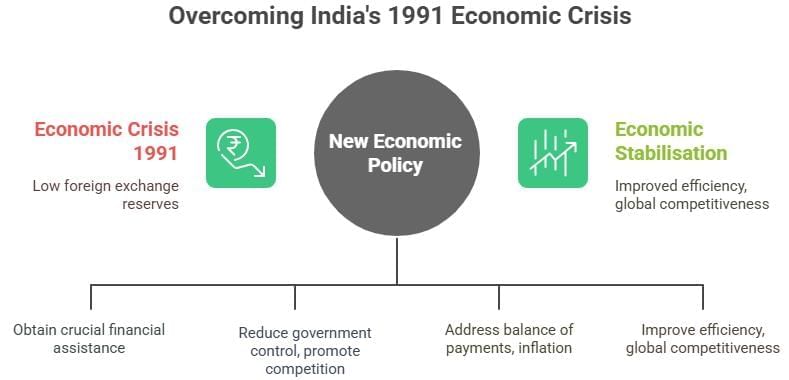
Background: The 1991 Economic Crisis
Causes of the Crisis
- Excessive government spending on development policies (e.g., poverty alleviation, unemployment) outpaced revenue.
- Heavy borrowing from domestic and international sources to cover expenditure.
- Imports (e.g., petroleum) exceeded export earnings, draining foreign exchange reserves.
- Rising prices of essential goods increased economic strain.
- Low foreign reserves (enough for only two weeks of imports) and inability to pay interest to international lenders.
Response to the Crisis
- India secured a $7 billion loan from the World Bank and the IMF.
- In return, India agreed to liberalise its economy, reduce government control, and promote competition.
- The New Economic Policy (NEP) was introduced in 1991, focusing on:
- Stabilisation measures: Address the balance of payments and inflation.
- Structural reforms: Improve economic efficiency and global competitiveness.
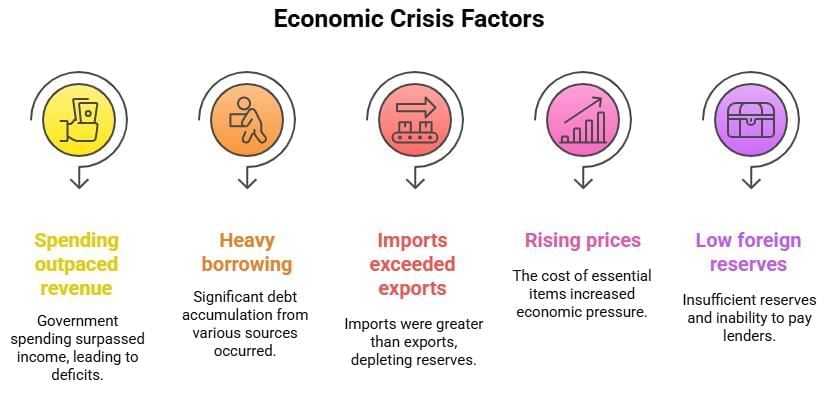
What is Liberalisation?
Liberalisation involves removing restrictive rules to promote economic growth and competition.
Deregulation of the Industrial Sector
Before 1991:
- Industrial licensing required government approval to start or close firms or set production levels.
- Many industries were reserved for the public sector; private participation was limited.
- Small-scale industries had exclusive rights to produce certain goods.
- Government-controlled prices and distribution of selected products.
Post-1991 Reforms:
- Industrial licensing was abolished for most industries (except alcohol, cigarettes, hazardous chemicals, etc.).
- Only a few industries (e.g., atomic energy, railways) remained reserved for the public sector.
- Restrictions in small-scale industries were lifted, allowing larger firms to produce reserved goods.
- Market-driven pricing replaced government-controlled pricing.
Financial Sector Reforms
- Shifted the Reserve Bank of India (RBI) role from regulator to facilitator.
- Allowed establishment of private sector banks (Indian and foreign).
- Raised the foreign investment limit in banks to ~74%.
- Banks gained the freedom to open new branches without RBI approval (if conditions were met).
- Foreign Institutional Investors (FIIs) are allowed to invest in Indian financial markets.
Tax Reforms
- Direct Taxes: Reduced income and corporate tax rates to encourage savings and compliance.
- Indirect Taxes: Introduced Goods and Services Tax (GST) in 2016 for a unified national market.
- Since 1991, income tax rates have been reduced to curb evasion and boost savings.
- Simplified tax procedures to reduce evasion and improve compliance
- Tax reforms are part of fiscal policy (taxation & public spending).
- Corporate tax rates have also been lowered.
- Indirect tax reforms aim for a unified national market.
GST was introduced in 2016 to increase revenue, reduce evasion, and simplify the tax structure.
Foreign Exchange Reforms
- Devalued the Indian rupee to boost foreign exchange inflow.
- 1991: Major foreign exchange reforms as part of external sector reforms.
- Rupee devalued to tackle balance of payments crisis.
- Now, exchange rates are set by supply and demand in the forex market.
- Marked shift from government control to market-driven exchange rates.
Trade and Investment Reforms
- Removed import licensing (except for hazardous goods).
- Eliminated quantitative restrictions on imports/exports by 2001.
- Export duties have been abolished to boost the global competitiveness of Indian products.
- Reduced tariff rates and export duties to enhance global competitiveness.
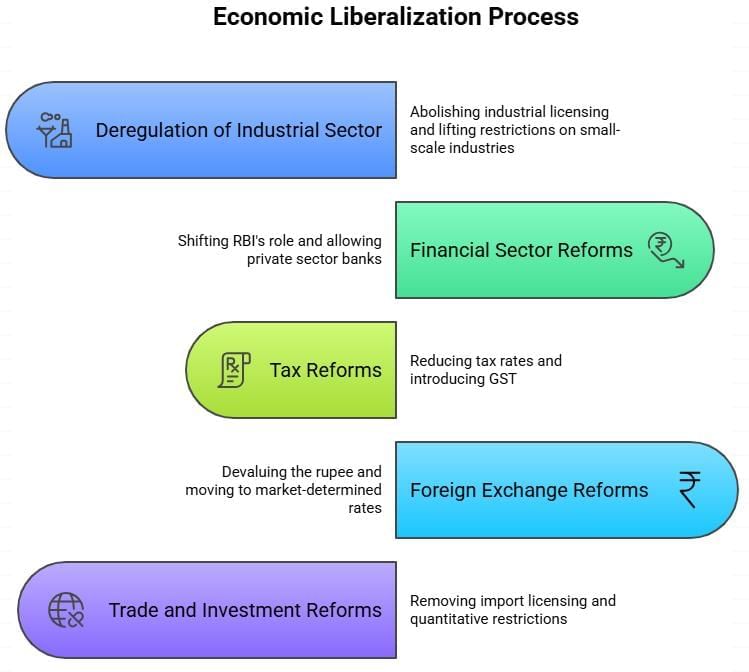
What is Privatisation?
Privatisation transfers ownership or management of public sector enterprises (PSEs) to the private sector to improve efficiency.
Methods
- Withdrawal of government ownership and management.
- Disinvestment: Selling part of PSE equity to the public.
Goals
- Improve financial discipline and modernise PSEs.
- Attract Foreign Direct Investment (FDI).
- Grant greater autonomy to PSEs (e.g., maharatnas, navratnas, miniratnas status).
Criticism
- Assets are undervalued during sales, causing government losses.
- Disinvestment funds are often used to cover revenue shortfalls, not reinvested in PSEs or social infrastructure.
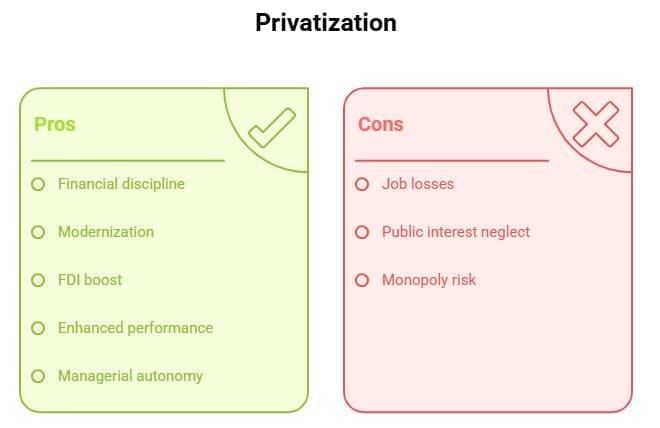
What is Globalisation?
Globalisation integrates India’s economy with the global economy, fostering interdependence.
Key Features
- Encourages cross-border trade, investment, and technology transfer.
- Promotes a “borderless world” where global events impact local economies.
Outsourcing
- Companies hire external services (e.g., call centres, IT support) from countries like India due to low costs and skilled labour.
- Enabled by advancements in IT and telecommunication.
World Trade Organisation (WTO)
- Founded in 1995, succeeding GATT (1948).
- Aims for a rule-based trading system, removing tariff/non-tariff barriers.
- Works in enhancing market access for member countries.
- India’s role: Advocates for fair trade rules and developing countries’ interests.
- Limited trade benefits as developed nations dominate global trade.
- Unfair agricultural subsidy policies by developed countries.
- Developing nations face market access restrictions in developed countries.
Impact of Reforms: An Assessment
GDP Growth
- Increased from 5.6% (1980–91) to 8.2% (2007–12), driven by the service sector.
- Growth is mainly driven by the service sector.
- Agriculture peaked in 2013–14, then fell.
- Agriculture slowed; industry showed fluctuating growth.
- 2012–15: Overall decline in growth rates.
- The service sector stayed strong, hitting 9.8% in 2014–15.
Industry dropped in 2012–13, then recovered.
Foreign Investment and Reserves
- FDI rose from $100 million (1990–91) to $30 billion (2016–17).
- Foreign reserves grew from $6 billion (1990–91) to $413 billion (2018–19).
Exports
- Strong growth in auto parts, tech software, textiles, and pharmaceuticals.
- Inflation remained manageable.
Challenges
- Employment: Failed to generate enough jobs despite GDP growth.
- Agriculture:
- Declining public investment in infrastructure.
- Higher production costs due to subsidy cuts.
- Increased competition from imports.
- Industry:
- Slow growth due to cheaper imports and poor infrastructure.
- Globalisation led to increased competition from foreign goods.
- Domestic industries struggle against low-cost imports.
- Poor infrastructure (e.g., power supply) limits industrial expansion.
- Free flow of goods affects local industries and employment.
- High non-tariff barriers restrict India's access to developed markets.
Example: The USA maintains textile quotas on India despite India's removal of export quotas.
- Disinvestment:
- 1991–92 target: ₹2,500 crore; actual: ₹3,040 crore.
- 2017–18 target: ₹1,00,000 crore; actual: ₹1,00,057 crore.
- Critics claim PSE assets are undervalued and sold, causing government losses.
- Proceeds often cover deficits instead of funding PSE growth or social infrastructure.
- Raises concerns about whether selling assets truly improves efficiency.
- Fiscal Policy:
- Tax cuts reduced revenue, limiting welfare spending.
- Limited the government's ability to raise revenue through customs duties.
- Tax incentives for foreign investors strained resources.
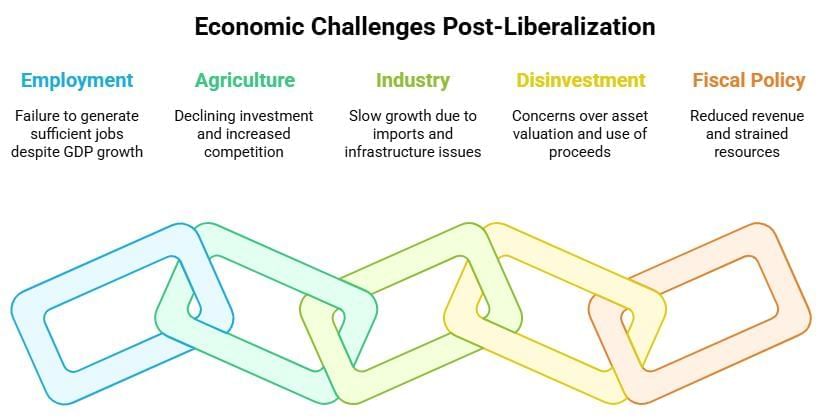
Conclusion
The 1991 reforms transformed India’s economy through liberalisation, privatisation, and globalisation, boosting GDP, foreign investment, and exports. However, challenges like insufficient job creation, agricultural slowdown, and industrial competition highlight the need for balanced policies. While globalisation offers access to global markets and technology, it also exposes India to international competition and market barriers, requiring careful navigation to maximise benefits.
|
64 videos|308 docs|51 tests
|
FAQs on Short Notes: Liberalisation, Privatisation, and Globalisation: An Appraisal - Economics Class 12 - Commerce
| 1. What were the main causes of the 1991 Economic Crisis in India? |  |
| 2. How did liberalisation impact the Indian economy? |  |
| 3. What role did privatisation play in India's economic reforms? |  |
| 4. How has globalisation influenced India's economic landscape? |  |
| 5. What are the key impacts of the economic reforms on Indian society? |  |




















